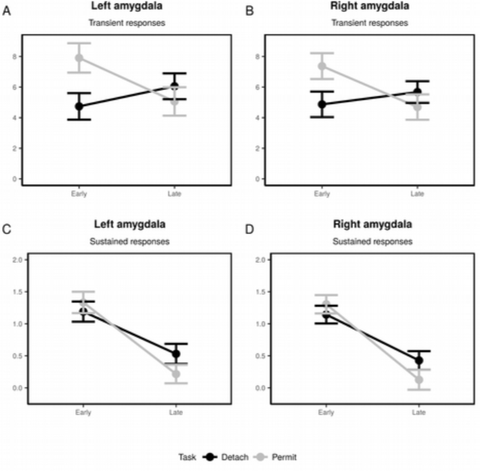A5
Volitional emotion regulation: The costs of control (completed)
This project aimed at elucidating the effectiveness and the potential costs of the inhibition of prepotent responses as a crucial volitional function. Using volitional emotion regulation as an example for the inhibition of particularly prepotent, since evolutionary acquired responses, different cognitive regulation strategies (distraction, volitional down- and up-regulation) were compared with respect to their behavioral and neural effectiveness, i.e., emotion regulation success, but operationalized along a prolonged time-scale, as this also allowed to examine potential costs of volitional emotion regulation as has been evidenced by paradoxical immediate and delayed regulatory after-effects in the activation of one core brain structure involved in emotion regulation, the amygdala. Such costs of volitional control have been reported for volitional emotion down-regulation, but have not been examined so far for other strategies such as distraction or volitional emotion up-regulation. Furthermore, the effectiveness and costs of emotion regulation strategies might differ depending on individual differences in the habitual use of regulation strategies, in emotional personality traits, in mental disorders characterized by dysfunctional emotion regulation, and in genetic predispositions. In Project A5, these issues were examined in detail in order to further elucidate the effectiveness, costs, and boundary conditions of the volitional control of the inhibition of prepotent responses.
Recent findings
Investigations of the neural correlates of volitional emotion regulation have so far mainly been concerned with the immediate effects of the presentation of emotion-eliciting stimuli and concomitant regulation instructions. In reality, however, emotion regulation extends across much longer time scales. In the present study, we therefore examined the immediate as well as short- and long-term effects of emotional regulation. We therefore conducted an fMRI study in a sample of N = 48 young healthy adults and compared neuronal responses to negative and neutral stimuli under the instructions to detach from and to actively permit any emotions that might arise in response to these stimuli. We investigated the temporal dynamics of activation changes within a trial, interactions between the task and subsequent rest periods, as well as re-encounters with the same emotional material after short (10 minutes) and long (1 week) time intervals. Negative stimuli elicited a strong response in affective regions of the brain, including the amygdala. The detachment instruction led to a decrease of this response, and to an increase of activation most prominently in the right middle frontal and inferior parietal cortex. Regulation efforts during the presentation of neutral stimuli also led to amygdala down-regulation, and also involved a similar, but less extended set of cortical regions. These effects primarily appeared as brief, or transient, responses in the amygdala, and prolonged, or sustained, responses in cortical regions. When comparing regulation- and post-regulation phases, we observed an interaction effect of time and task, indicating a partial reversal of regulation effects in activations (see Figure 1). The same interactions were found after 10 minutes and after 1 week. The results of this study corroborate existing results regarding the down-regulation of the amygdala and the concurrent activation of a right frontoparietal regulation network during detachment, and extend to different stimulus types. Finally, they demonstrate that the temporal dynamics are highly variable both within experimental trials and across regions, and so confirm previous reports that emotion regulation has an impact on amygdala activation at multiple time scales.

Figure 1. Summary statistics for the amygdala ROI during the regulation (early) and post-regulation phase (late)
Publications
- Diers, K., Dörfel, D., Gärtner, A., Schönfeld, S., Walter, H., Strobel, A., Brocke, B. (2021). Should we keep some distance from distancing? Regulatory and post-regulatory effects of emotion downregulation. PLoS ONE, 16(9): e0255800. doi.org/10.1371/journal.pone.0255800
- Dörfel, D.*, Gärtner, A.*, & Scheffel, C.* (2020). Resting state cortico-limbic functional connectivity and dispositional use of emotion regulation strategies: A replication and extension study. Frontiers in Behavioral Neuroscience, 14, 128. *All authors contributed equally and are listed in alphabetical order. doi: 10.3389/fnbeh.2020.00128
- Gärtner, A., Dörfel, D., Diers, K., Witt, S. H., Strobel, A., Brocke, B. (2019). Impact of FAAH genetic variation on fronto-amygdala function during emotional processing. European Archives of Psychiatry and Clinical Neuroscience, 269(2),209–221. doi:10.1007/s00406-018-0944-9
- Scheffel, C., Diers, K., Schönfeld, S., Brocke, B., Strobel, A. & Dörfel, D. (2019). Cognitive emotion regulation and personality: an analysisof individual differences in the neural and behavioral correlates of successful reappraisal. Personality Neuroscience, 2(e11), 1-13. doi:10.1017/pen.2019.11
- Buruck, G., Wendsche, J., Melzer, M., Strobel, A., & Dörfel, D. (2014). Acute psychosocial stress and emotion regulation skills modulate empathic reactions to pain in others. Frontiers in Psychology, 5, 517. doi:10.3389/fpsyg.2014.00517
- Diers, K., Weber, F., Brocke, B., Strobel, A., & Schönfeld, S. (2014). Instructions matter: a comparison of baseline conditions for cognitive emotion regulation paradigms. Frontiers in Psychology, 5, 347. doi:10.3389/fpsyg.2014.00347
- Enge, S., Behnke, A., Fleischhauer, M., Küttler, L., Kliegel, M., & Strobel, A. (2014). No evidence for true training and transfer effects after inhibitory control training in young healthy adults. Journal of Experimental Psychology. Learning, Memory, and Cognition, 40, 87-1001. doi:10.1037/a0036165
- Enge, S., Fleischhauer, M., Lesch, K.-P., Reif, A., & Strobel, A. (2014). Variation in key genes of serotonin and norepinephrine function predicts gamma-band activity during goal-directed attention. Cerebral Cortex, 24(5), 1195-205. doi:10.1093/cercor/bhs398
